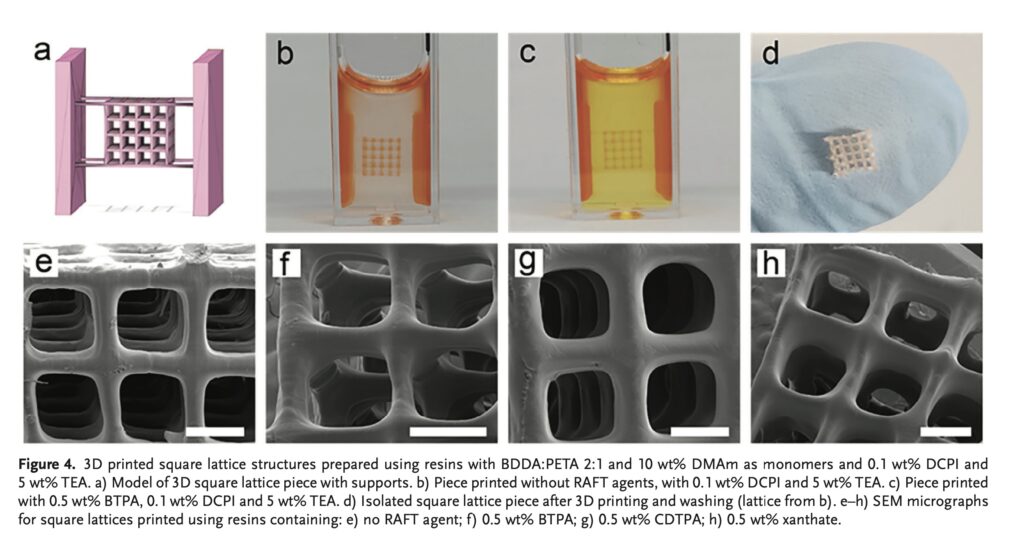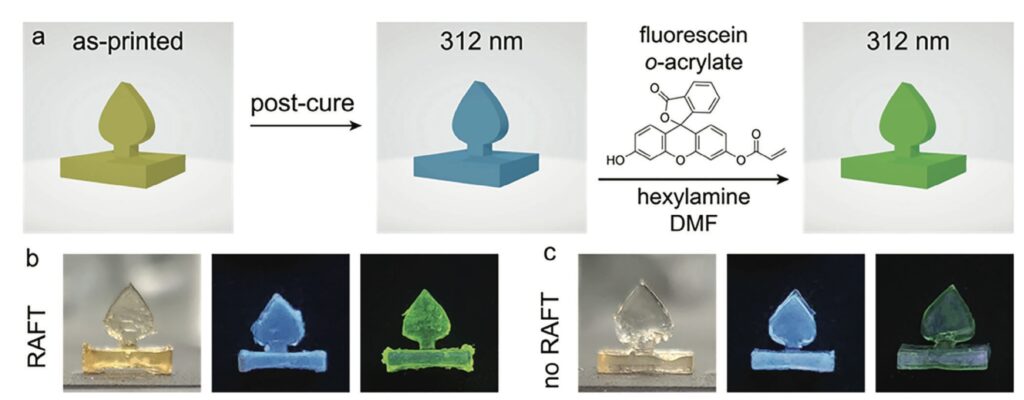A recent study published in Advanced Materials Technologies by Nathaniel Corrigan, Xichuan Li, Jin Zhang, and Cyrille Boyer delves into the advancements in xolography, a pioneering volumetric 3D printing method. Conducted by researchers from the Cluster for Advanced Macromolecular Design and the School of Chemical Engineering at UNSW Sydney’s Boyer Lab, along with collaboration from University of California San Diego, the study presents novel resin formulations and parameters that could significantly advance xolography.
Volumetric 3D printing, particularly xolography, offers the promise of creating intricate, multi-material objects with unprecedented speed and precision. By utilizing a novel approach involving thiocarbonylthio in a process akin to reversible addition-fragmentation chain transfer (RAFT) radical polymerization, the team not only enhances the properties of printed objects but also significantly improves the control and precision of the fabrication process. This research could open new avenues for industrial applications and marks a critical step forward in the evolution of 3D printing technologies.
Through their RAFT process, the team achieves a controlled polymerization for Xolography, the volumetric 3D printing method pioneered by the startup Xolo. Xolography utilizes multiple light beams of different wavelengths that intersect within a tank of monomers. Typically, this involves one projection and one diode laser-based light source. Activation of the dual-color photoinitiator (DCPI) occurs only when both light sources are present, enabling precise control over the polymerization process.
At specific points within the monomer tank, photoinitiators trigger polymerization, ideally resulting in a well-defined, intricately detailed object in a swift manner. Xolography’s promise extends to its tunable properties and the ability to produce objects without the need for supports, offering potential savings in both money and time. Another notable advantage explored by the research team is the continuous printing within a single vat using multiple materials.
In their investigation, the team focused on resins suitable for Xolography, particularly emphasizing (multi)vinyl monomers, possibly due to their affinity for Hazmat suits. They successfully created a 200 μm prism lattice structure using resins like bisphenol A diglycidyl ether diacrylate (BDDA) and other materials such as Diurethane Dimethacrylate (DUDMA). Subsequently, a Thiol-Michael click chemistry step was also employed. In one experiment, this Thiol-Michael reaction enabled an object to glow in the dark after printing. Such post-printing modifications hold significant industrial interest.
The research team further explored the creation of multi-material structures by printing with two distinct resins. Initially, they used resins containing Diurethane Dimethacrylate (DUDMA) and BTPA ((Z)-2-(2-tert-butoxycarbonyl amino-thiazol-4-yl)-2-pentenoic acid) as a RAFT agent. These were first printed and then modified using the Thiol-Michael reaction. Following this modification, a new resin containing Pentaerythritol tetraacrylate (PETA), a dark-curing photoinitiator (DCPI), and triethylamine (TEA) was printed on top of the first. Despite PETA’s associated risks, including dermal toxicity, and TEA’s fishlike smell and potential respiratory and ocular irritations, the process successfully produced a multi-material object.
It’s lovely that such experienced groups of researchers are taking an interest in volumetric 3D printing. I’m a bit concerned about the chemistry personally, but hope that it will be safe within the 3D printers and their environment. Volumetric 3D printing appears to be the next step in the more rapid construction of parts. Just because it seems logical doesn’t mean it will be scalable and a reliable process.
I’m enthused about the potential to make things with less manual post-processing. Multi-material parts could also lead to new kinds of parts, such as microfluidic parts or parts for industrial manufacturing. We may be able to significantly extend vat polymerization with volumetric 3D printing. However, we must not assume that this is a foregone conclusion. Part size may be limited in these printers, for example, or material costs could make these processes too expensive for industrial manufacturing applications. We do not fully understand the limitations of this technology and for which parts it would be best suited. Additionally, an installed base of very low-cost SLA and DLP systems could mean that an industry may not want to change. There are also competing processes available, such as the renewed inkjet processes from Quantica, while other light-based technologies are expanding their range of properties. But, this is a very promising look into what xylography could do.
Subscribe to Our Email Newsletter
Stay up-to-date on all the latest news from the 3D printing industry and receive information and offers from third party vendors.
You May Also Like
3D Printing Webinar and Event Roundup: April 21, 2024
It’s another busy week of webinars and events, starting with Hannover Messe in Germany and continuing with Metalcasting Congress, Chinaplas, TechBlick’s Innovation Festival, and more. Stratasys continues its advanced training...
3D Printing Webinar and Event Roundup: April 14, 2024
We’re starting off the week’s 3D printing webinars and events at ASTM AMCOE’s 11th Snapshot Workshop and MACH Exhibition. Stratasys continues its advanced training courses, SME is holding a virtual...
Polly the Duck to Receive 3D Printed Bill Prosthetic
In Williamson County, Texas, a story of resilience, innovation, and cross-community effort is unfolding, illustrating the bond between humans and wildlife. All Things Wild, a wildlife rehabilitation center, has been...
3D Printing News Briefs, April 3, 2024: Kickstarter FDM 3D Printer, Artificial Eyes, & More
In 3D Printing News Briefs today, we’re talking about an FDM 3D printer on Kickstarter, advancements in artificial eye creation, and 3D printed solenoids for electromagnets. Then we’ll move on...


































